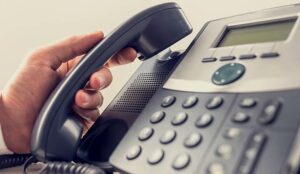Steve Bell of Talkdesk introduces us to the predictive dialler and its role within the contact centre.
Automated dialling in its various forms is a tremendous productivity tool for companies making outbound calls. Of the various dialling modes, predictive is the most aggressive and offers the most productivity. The impact of predictive diallers can be staggering.
In a B2C scenario, with relatively short talk times, agents can go from an average of four contacts an hour manually dialling to 16 or more using a predictive dialler.
If the average revenue per call is $100, that improvement bumps revenue from $400 to $1600 per agent per hour. Multiply that by the number of agents and you can see why predictive diallers pay for themselves many times over. On the downside, predictive dialling also faces the most scrutiny for its aggressiveness.
The vast majority of regulatory restrictions have come about because of predictive dialling technology and the practices of those who use it.
This blog does not delve into the discussion of dialler mode comparisons but is rather an explanation of the fundamentals of predictive dialler technology.
The History of the Predictive Dialler
Predictive diallers were born in the mid 1980s during an economic downturn that saw a spike in debt and a fast-growing debt collection business.
Companies, including major banks, finance companies and collections agencies, expanded call centres to respond to the arrears crisis for credit cards, auto loans, student loans and other forms of debt.
These companies were looking for technology that could maximize the productivity of agents on the phones arranging payment agreements with debtors.
At the same time, telemarketing companies were looking for the same type of technology to maximize the productivity of telemarketers calling to sell products and services by phone.
The problem they were trying to address was that their target audience would get up in the morning and go to work until the evening.
During a large portion of the day, agents were calling and nobody was answering. Agents were tremendously unproductive, commonly averaging only three or four contacts per agent per hour.
In the ’80s a handful of “first-generation” hardware-based predictive dialler companies were formed to address the need – companies like Davox, Mosaix and Melita.
Then, in the mid ’90s, a new generation of “soft diallers” was born, which eschewed their own dialling hardware for software that connected to existing telephony systems, a design favoured by telecom & IT managers.
How Basic Predictive Dialling Algorithms Work
Predictive diallers have five main components:
- Contact/list management software (often in conjunction with CRM/database integration) that determines which numbers to call and when
- Admin software to manage agents
- Software to identify call progress results (e.g. knowing the difference between a busy signal, a no answer, a live “hello” and a voicemail)
- Algorithms that determine how much to dial (see Concurrent Call Ratio below)
- Reporting to track results
For illustrative purposes, the graphic below depicts an example of B2C connect (hit) rates during a day – in this case, calling landlines not mobile numbers. In this simplified example, the hit rate is only 50% in the morning, meaning there’s a one in two chance someone will answer the phone.
Later in the morning, that hit rate drops to approximately 25%. Then towards late afternoon as people start returning home, it increases again.
The predictive dialler runs through a list of numbers to dial, with the algorithm determining how many calls to place per agent. This is known as the Concurrent Call Ratio. The algorithm is tracking several things, including:
- Real-time hit rate
- Historical hit rate
- Number of agents available
- Real-time and average call durations of the agents
So, for instance, in the morning where the hit rate is 50%, the system will place roughly two dials per agent, with the prediction that one will not answer. During the day, the dialler might place roughly four dials per agent, because there is only a 25% chance of getting a “live hello”.
In a perfect world, as soon as an agent finishes a call, the algorithm will have timed the “dial ahead” so that the next live connection goes straight to the agent.
The maths works best with a larger pool of agents. But even in this case, there is inevitably the scenario of the dialler placing a call, getting an answer, but no agent is available to take it.
This is one reason you often hear a pause on the other end of the line when you pick up your ringing phone. Or the dialler is trying to figure out if you are a human or a recorded message.
The Impact of Regulations
As mentioned earlier, a number of regulations have impacted the functionality and operation of predictive diallers.
Federal Communications Commission (FCC) regulations today dictate that if someone answers but no agent is available within two seconds of the person’s greeting, the call is considered “abandoned” and requires that the dialler play a recorded message.
Most country regulations state that you are not allowed to go over a set percent abandonment rate for each individual campaign over a period of time. Most diallers today allow you to set that abandon rate threshold.
Additionally, the Telephone Consumer Protection Act (TCPA) requires that companies wishing to dial mobile numbers must have an e-signature with the contact showing approval. This obviously has implications for the contact management software component.
This blog post has been re-published by kind permission of Talkdesk – View the Original Article
For more information about Talkdesk - visit the Talkdesk Website
Call Centre Helper is not responsible for the content of these guest blog posts. The opinions expressed in this article are those of the author, and do not necessarily reflect those of Call Centre Helper.
Author: Talkdesk
Published On: 26th Feb 2020 - Last modified: 3rd Mar 2020
Read more about - Guest Blogs, Talkdesk






 Talkdesk is a global customer experience leader for customer-obsessed companies. Our contact center solution provides a better way for businesses and customers to engage with one another.
Talkdesk is a global customer experience leader for customer-obsessed companies. Our contact center solution provides a better way for businesses and customers to engage with one another. 












